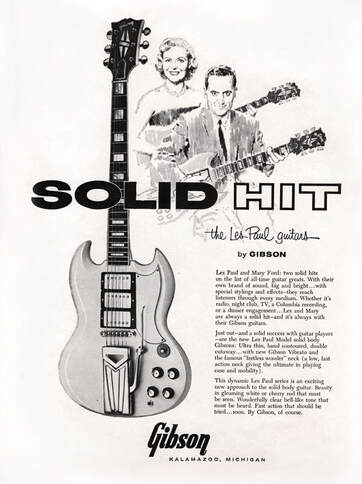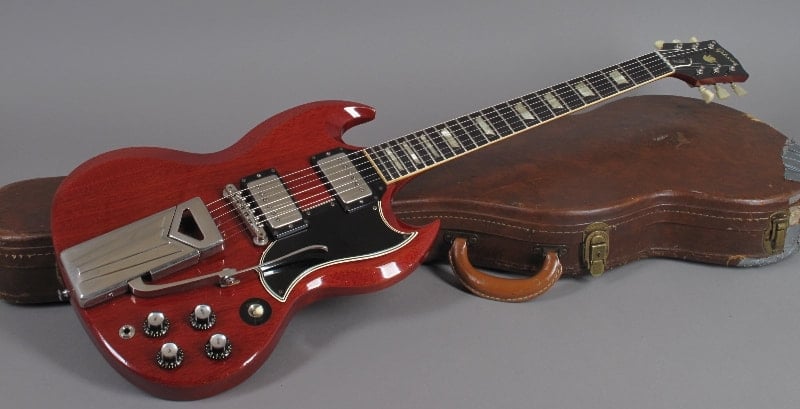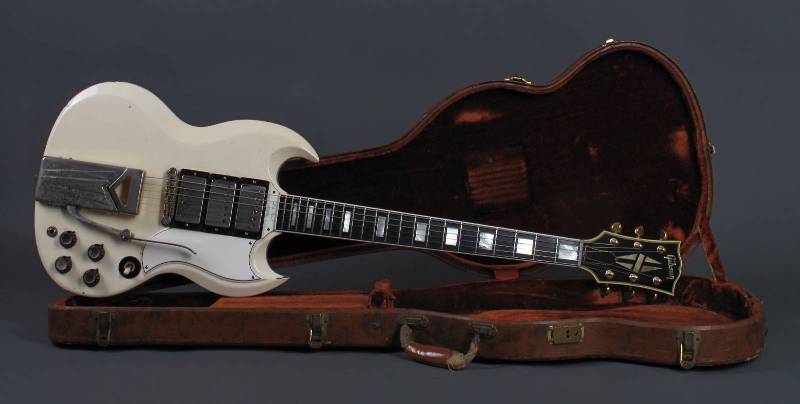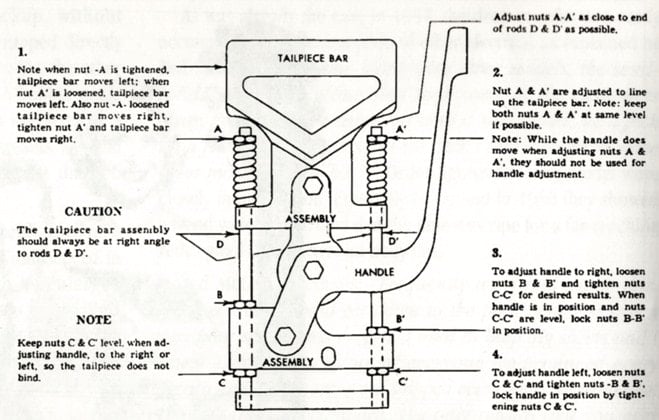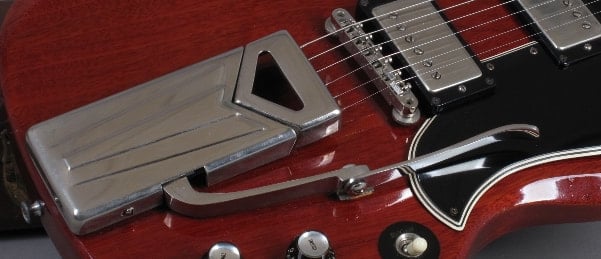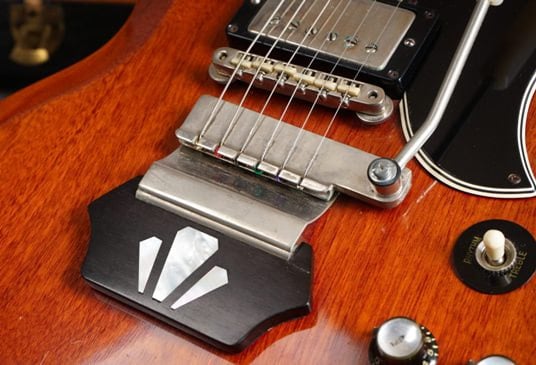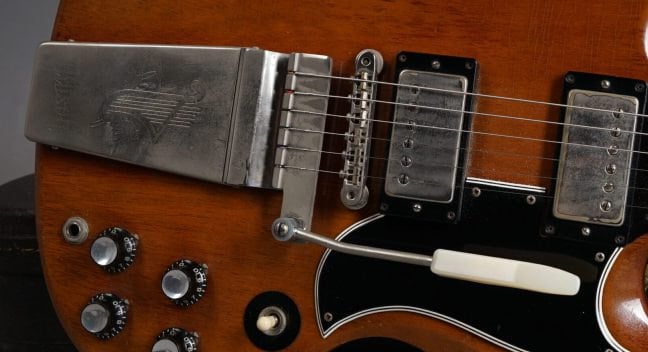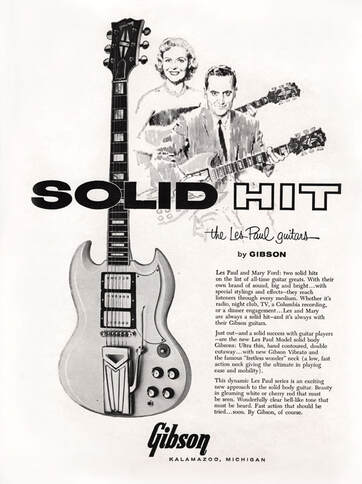 1961 advert of the new "SG" shaped of the Les Paul Custom
1961 advert of the new "SG" shaped of the Les Paul Custom
Despite the innovations on the Les Paul model following one another, such as the PAF humbuckers or the Standard’s new transparent top, sales were still not taking off. This possibly happened as a result of a sort of internal cannibalization, due to the success of the new Gibson "thinline" ES-335/345/355, and of the new electric guitars launched by other brands.
The initial success of cheap solid-bodies such as the Les Paul Junior, Special and TV model gave a clear signal to Gibson: electric guitars had to be more affordable. And not only that: it was also evident that they had to have a more modern design.
The first sign of an imminent change in the entire Gibson solid-body line dates back to 1958, when the Les Paul Junior, TV and Special were redesigned with a double cutaway. On November 1st, 1959 the Les Paul Special and the TV Model changed their names into SG Special and SG TV, where "SG" stands for Solid Guitar (just like "ES" used to stand for "Electric Spanish" and "EB" for "Electric Bass"), and the name "Les Paul" was removed.
However, if on the one hand the name “Les Paul” was immediately removed from the Special’s headstock, on the other the change was not so immediate for the TV. Thus, musicians continued to call it Les Paul TV, also since the technical specifications of the new SG guitars were initially the same as those of the Les Paul Special and Les Paul TV.
The aim, however, was that of radically modifying Gibson solid-bodies, giving them easier access to the last frets and a lighter and more comfortable body. As Ted McCarty stated: “The solid body guitar has always been a weight issue and this new design made it easy to get rid of some of the weight and give it a new look. When we came out with the SG, we no longer had the original Les Paul.” In fact, many guitarists complained about the weight and often about the lack of balance of the Les Paul.
The first model to be redesigned was, in the late 1960, the Les Paul Standard and, shortly after, the Custom. The new body, in Honduran mahogany like the one of the previous Standard, was extremely thin (1 5/16") and did not have a carved top. The body edges were deeply chamfered, including the inside of the two new pointed horns. These differences were also highlighted by the new finishes, Cherry Red for the Standard and Solid White for the Custom.
The drastic weight reduction obviously affected the full, sustained tone typical of the old Les Paul, but the new SG had a brighter sound, well fitting into the mix, as recalled by the advertising flyers, “Tone is clear and bell-like,” and, most importantly, the weight was well balanced and the guitarists no longer had to support the neck with their hand in order to hold the guitar in the right position.
The initial success of cheap solid-bodies such as the Les Paul Junior, Special and TV model gave a clear signal to Gibson: electric guitars had to be more affordable. And not only that: it was also evident that they had to have a more modern design.
The first sign of an imminent change in the entire Gibson solid-body line dates back to 1958, when the Les Paul Junior, TV and Special were redesigned with a double cutaway. On November 1st, 1959 the Les Paul Special and the TV Model changed their names into SG Special and SG TV, where "SG" stands for Solid Guitar (just like "ES" used to stand for "Electric Spanish" and "EB" for "Electric Bass"), and the name "Les Paul" was removed.
However, if on the one hand the name “Les Paul” was immediately removed from the Special’s headstock, on the other the change was not so immediate for the TV. Thus, musicians continued to call it Les Paul TV, also since the technical specifications of the new SG guitars were initially the same as those of the Les Paul Special and Les Paul TV.
The aim, however, was that of radically modifying Gibson solid-bodies, giving them easier access to the last frets and a lighter and more comfortable body. As Ted McCarty stated: “The solid body guitar has always been a weight issue and this new design made it easy to get rid of some of the weight and give it a new look. When we came out with the SG, we no longer had the original Les Paul.” In fact, many guitarists complained about the weight and often about the lack of balance of the Les Paul.
The first model to be redesigned was, in the late 1960, the Les Paul Standard and, shortly after, the Custom. The new body, in Honduran mahogany like the one of the previous Standard, was extremely thin (1 5/16") and did not have a carved top. The body edges were deeply chamfered, including the inside of the two new pointed horns. These differences were also highlighted by the new finishes, Cherry Red for the Standard and Solid White for the Custom.
The drastic weight reduction obviously affected the full, sustained tone typical of the old Les Paul, but the new SG had a brighter sound, well fitting into the mix, as recalled by the advertising flyers, “Tone is clear and bell-like,” and, most importantly, the weight was well balanced and the guitarists no longer had to support the neck with their hand in order to hold the guitar in the right position.
In the first half of 1961 the cheap solid-bodies also adopted new bodies, as announced in a letter to the dealers dated June 28th: “The new contour body design is now a standard feature on the SG Special, the Les Paul Jr., and the SG TV models.” However, the SG TV changed its finish from yellow to white - "Cream" on the catalog - only at the end of 1961, while white was only available for the Special on request. At the same time, the ¾ versions went out of production, the last leftovers being sold out in the autumn of 1961, thus the only ¾ model remaining on the catalog was the Melody Maker.
The new pointed-horn-body Gibsons are commonly called ‘SG models’, while those with a rounded horn or horns are called ‘Les Paul Model’. However, the term SG had already been officially used for the Special and the TV in late 1959, even though they still used to have a Les Paul body shape - which is why they are sometimes called Les Paul Style SG or Les Paul/SG. Conversely, the first Les Paul Standards, which had not been officially called SGs, but had a flat-top body with pointed horns, are called SG style Les Paul Standards or SG/Les Pauls.
Les Paul was not satisfied with the new guitars bearing his name: “I was not happy with that guitar, I didn't like the horns, the cutaway... too sharp.” This, combined with only a slight increase in sales of the SG guitars (+11.5% in 1961 compared to 1960), was the cause of the missed renewal, in 1962, of the contract between Les Paul and Gibson. Furthermore, the prospect of a divorce with his wife Mary Ford led Les Paul to consider the idea of a retirement from the music scene.
The term ‘Les Paul’ was used by Gibson until September 1963, when it was removed from the truss rod cover. From October onwards, the only names used were SG Standard, SG Custom, SG Special and SG Junior - the TV models went out of production.
The new pointed-horn-body Gibsons are commonly called ‘SG models’, while those with a rounded horn or horns are called ‘Les Paul Model’. However, the term SG had already been officially used for the Special and the TV in late 1959, even though they still used to have a Les Paul body shape - which is why they are sometimes called Les Paul Style SG or Les Paul/SG. Conversely, the first Les Paul Standards, which had not been officially called SGs, but had a flat-top body with pointed horns, are called SG style Les Paul Standards or SG/Les Pauls.
Les Paul was not satisfied with the new guitars bearing his name: “I was not happy with that guitar, I didn't like the horns, the cutaway... too sharp.” This, combined with only a slight increase in sales of the SG guitars (+11.5% in 1961 compared to 1960), was the cause of the missed renewal, in 1962, of the contract between Les Paul and Gibson. Furthermore, the prospect of a divorce with his wife Mary Ford led Les Paul to consider the idea of a retirement from the music scene.
The term ‘Les Paul’ was used by Gibson until September 1963, when it was removed from the truss rod cover. From October onwards, the only names used were SG Standard, SG Custom, SG Special and SG Junior - the TV models went out of production.
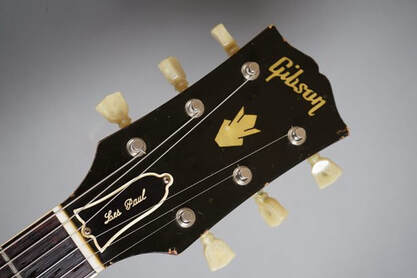 This 1962 SG Style Les Paul Standard enlarged headstock still had the "Les Paul" name on the plastic truss rod cover and was characterized by the crown-shaped inlay (Courtesy of Guitar Point)
This 1962 SG Style Les Paul Standard enlarged headstock still had the "Les Paul" name on the plastic truss rod cover and was characterized by the crown-shaped inlay (Courtesy of Guitar Point)
The neck of the SG initially remained the same "extra slim, low action" of the latest Les Paul Standards of 1960, being slightly enlarged between the end of 1962 and 1963. The former had a slightly fragile neck-body junction and some had a tendency to break there. Thus, the neck tenon was reinforced in 1963.
The headstock was slightly widened in favor of a more balanced look. The Gibson logo, initially at least, remained a golden silkscreen and a crown-shaped inlay was placed in the center of the headstock. On the Custom the name "Les Paul Custom" was moved from the truss rod cover to a white plastic plate between the neck pickup and the neck.
The pickguard was redesigned in the shape of an angel wing, 3-ply white for the Custom and 4-ply black for the Standard and the Special, while on single-pickup models it was 2-ply black.
The "PATENT APPLIED FOR" sticker on the humbuckers was changed into "PATENT PENDING" in 1962 and into "PATENT #2,896,491" at the end of the same year. Paradoxically, this number did not refer to the pickup patent, but to that of the trapeze tailpiece! At the beginning of 1960 the bobbins had more windings and a shorter Alnico V magnet, called the M56, replaced the previous M55, both on the Standard and the Custom’s humbuckers, but also on the Special, TV and Junior P-90s.
The headstock was slightly widened in favor of a more balanced look. The Gibson logo, initially at least, remained a golden silkscreen and a crown-shaped inlay was placed in the center of the headstock. On the Custom the name "Les Paul Custom" was moved from the truss rod cover to a white plastic plate between the neck pickup and the neck.
The pickguard was redesigned in the shape of an angel wing, 3-ply white for the Custom and 4-ply black for the Standard and the Special, while on single-pickup models it was 2-ply black.
The "PATENT APPLIED FOR" sticker on the humbuckers was changed into "PATENT PENDING" in 1962 and into "PATENT #2,896,491" at the end of the same year. Paradoxically, this number did not refer to the pickup patent, but to that of the trapeze tailpiece! At the beginning of 1960 the bobbins had more windings and a shorter Alnico V magnet, called the M56, replaced the previous M55, both on the Standard and the Custom’s humbuckers, but also on the Special, TV and Junior P-90s.
In 1962 the brass saddles of the ABR-1 Tune-O-Matic bridge were replaced by white nylon ones and a thin metal wire was used to hold the bridge pieces intact if a string broke.
The new Gibson Sidewinder Vibrola, previously placed on the ES-355 and on some ES-335s, was standard for the new Standards and Customs. Someone mistakenly calls this vibrato "Lonnie Mack", even though Lonnie used a special Bigsby. According to the 1962 catalog the “New Gibson Vibrato operates in direction of pick strokes; swings out of way for rhythm playing.” This new vibrato had serious problems returning to the correct position after use, to the extent that some people would joke about it and say that it went out of tune just looking at it! “We used to make those in the machine shop where I worked. There were molded (cast) parts. We called it the 'Sidewinder'. It never worked,” recalls Jim Hutchinson, who started working for Gibson in the early 1960s. Some guitarists, knowing the drawback of the Gibson Vibrola, ordered their SG Standard or Custom with a Bigsby B5 or B5G.
The new Gibson Sidewinder Vibrola, previously placed on the ES-355 and on some ES-335s, was standard for the new Standards and Customs. Someone mistakenly calls this vibrato "Lonnie Mack", even though Lonnie used a special Bigsby. According to the 1962 catalog the “New Gibson Vibrato operates in direction of pick strokes; swings out of way for rhythm playing.” This new vibrato had serious problems returning to the correct position after use, to the extent that some people would joke about it and say that it went out of tune just looking at it! “We used to make those in the machine shop where I worked. There were molded (cast) parts. We called it the 'Sidewinder'. It never worked,” recalls Jim Hutchinson, who started working for Gibson in the early 1960s. Some guitarists, knowing the drawback of the Gibson Vibrola, ordered their SG Standard or Custom with a Bigsby B5 or B5G.
Between 1962 and 1963 Gibson abandoned the Sidewinder in favor of a new Knife-Edge Vibrola, hinged in an ebony block with pearl inlays and screwed to the body of the Custom and Standard. The last Standards and Customs of late 1963 and those made after the name was changed had a Deluxe Vibrola, or Lyre Vibrola (GV-55N and GV-75G), characterized by an elongated metal cover engraved with the Gibson logo and a lyre and, initially, a plastic handle that unfortunately used to break easily. The Special, TV and Junior had a small Maestro Vibrola, similar to the one used on Epiphone solid-bodies.
Many guitarists used the SG, especially Robby Krieger from The Doors and Angus Young from AC/DC, but also Eric Clapton, George Harrison, Derek Trucks, Tony Iommi, Pete Townshend, Frank Zappa, Carlos Santana, Billy Gibbons, Link Wray and Todd Rundgren.
Antonio Calvosa

